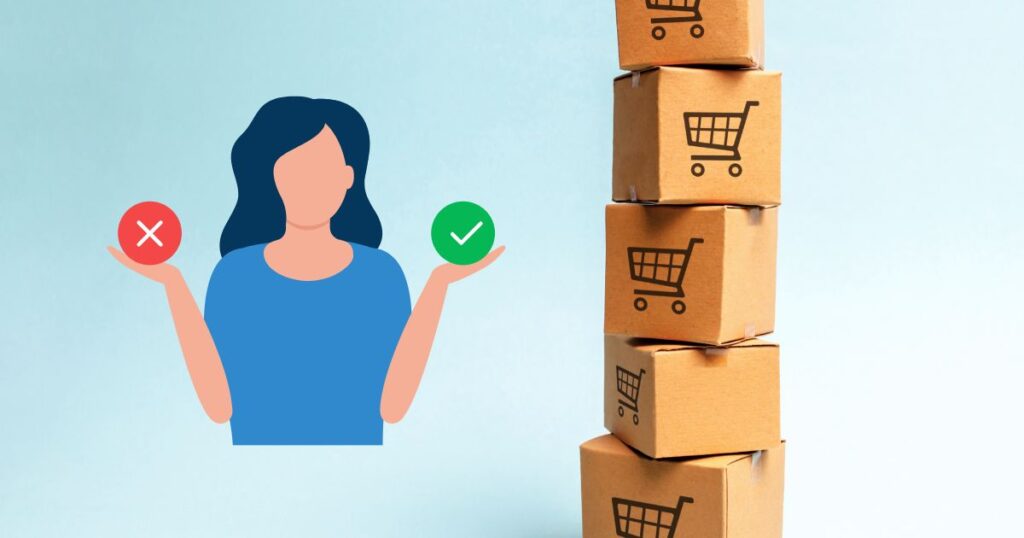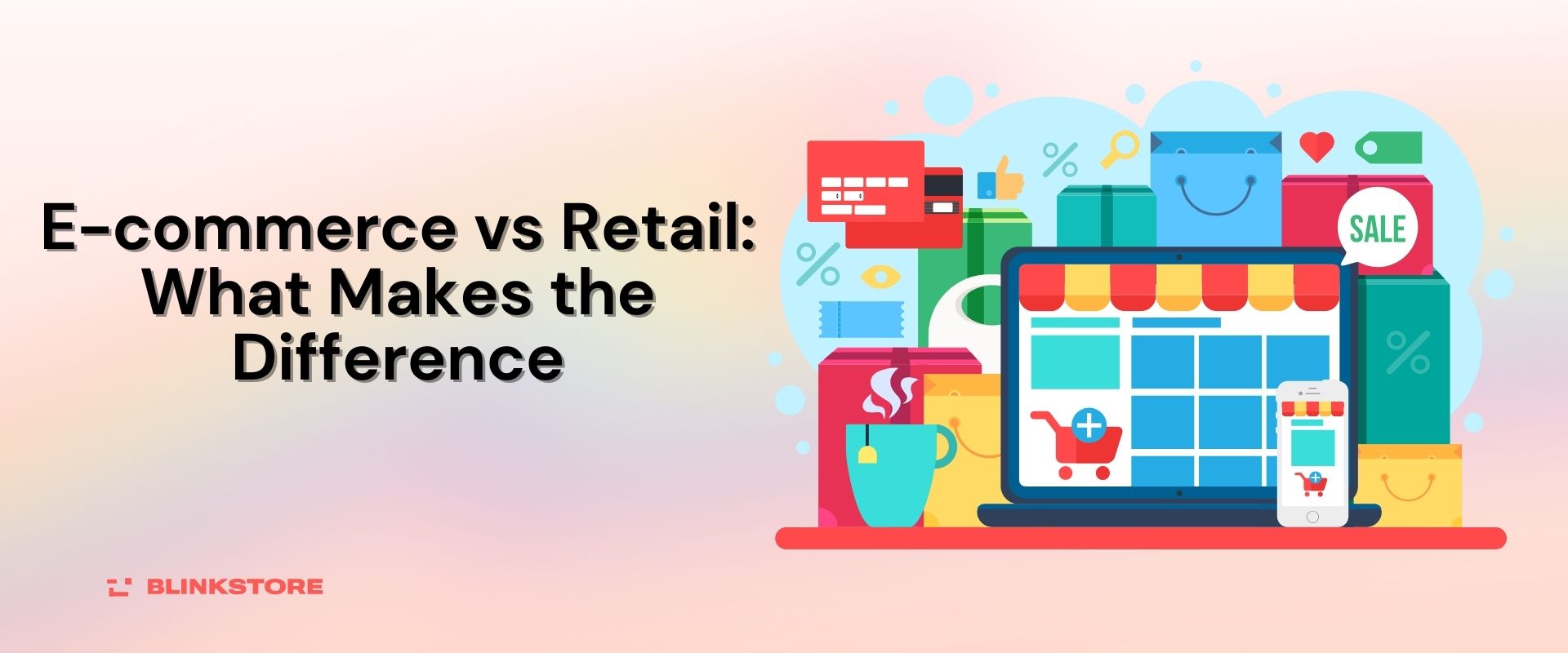You’re witnessing the daily expansion of digital footprints, intensifying the clash between online and offline retail. It is now essential to understand the distinctions between traditional retail and e-commerce. Dive into our blog as we unravel the distinctions between e-commerce and the traditional retail sector. Let’s explore.
Table of Contents
Defining E-Commerce and Retail
Let’s strip it down. Retail is the tangible, old setup gracing our streets. For example the physical stores, the storefront allure.
On the flip side, E-Commerce is where a simple click can transform into a purchase. It’s about the unique experience of where and how you make those acquisitions.
E-Commerce vs Retail: The Difference

1. Platform:
E-commerce: Transactions seamlessly unfold through e-commerce platforms or mobile applications. This method lets customers explore, choose, and electronically purchase products. From the comfort of their digital devices.
Retail: In contrast, retail transactions unfold within the physical confines of stores. This provides customers with a tangible, in-person shopping experience.
2. Accessibility:
E-commerce: The convenience of round-the-clock shopping, e-commerce allows customers to make purchases from any location with an internet connection. The virtual storefront is always open.
Retail: Operating within fixed hours, retail requires customers to physically visit the store during specified timeframes for their purchases.
Statistic: Studies show that 53% of online shoppers expect a website to load in three seconds or less. Speed up your e-commerce website to enhance accessibility.
3. Interaction:
E-commerce: Interaction is multi-faceted, encompassing user interfaces, product visuals, and detailed descriptions. Customer service is often delivered through online chat or email, fostering a seamless virtual engagement.
Retail: Thriving on face-to-face interactions, retail provides customers with the opportunity to physically engage with products. And interact with sales representatives, creating a personalized shopping experience.
Pro Tip: Install chatbots on e-commerce platforms to enhance customer service and provide instant responses to queries.
4. Inventory:
E-commerce: Often relying on centralized warehouses and incorporating dropshipping, e-commerce demands effective inventory management for timely shipping. Products may not be physically present at the point of purchase.
Retail: Requires on-site inventory management, with products on display and readily available for immediate purchase, offering a tangible shopping experience.
5. Payment:
E-commerce: Typically involves digital payment methods, such as credit/debit cards, digital wallets, or other electronic payment systems, offering a swift and secure transaction process.
Retail: Offers flexibility with a variety of payment methods, including cash, credit cards, and sometimes mobile payments, catering to diverse customer preferences.
Tool: Implement contactless payment options in retail stores for a modern and efficient payment experience.
6. Convenience:
E-commerce: The convenience of shopping from the comfort of home, allowing for easy price comparison and review reading before making a purchase decision.
Retail: Provides immediate access to products, allowing customers to physically inspect and take items home immediately after purchase.
Pro Tip: Enhance the in-store shopping experience by implementing digital price displays and interactive product information kiosks.
7. Overhead Costs:
E-commerce: Tends to have lower overhead costs due to the absence of physical storefronts. Operations can be centralized, reducing expenses associated with maintaining brick-and-mortar establishments.
Retail: Incurs costs related to maintaining physical stores, including rent, utilities, and staffing, contributing to potentially higher overhead costs.
8. Global Reach:
E-commerce: Holds the potential to reach a global audience, enabling businesses to transcend local boundaries and connect with customers worldwide.
Retail: Primarily serves a local or regional market unless integrated into a large chain with widespread locations.
Pro Tip: Optimize e-commerce websites for international shipping and provide clear information on shipping policies to attract global customers.
9. Personalization:
E-commerce: Leverages data analytics for personalized recommendations and targeted marketing tailored to individual customers, enhancing the overall online shopping experience.
Retail: Relies more on in-person interactions as the foundation for personalization, with sales representatives providing personalized assistance.
Tool: Implement customer relationship management (CRM) systems for e-commerce businesses to enhance personalization efforts.
10. Returns and Exchanges:
E-commerce: Typically involves a return process that includes shipping items back to the seller, which may take time and incur shipping costs.
Retail: Allows customers to promptly return or exchange items in-store, offering immediate resolution and fostering customer satisfaction.
E-Commerce vs Retail for Consumers

Let’s understand how the E-commerce and retail industry help consumers:
1. Shopping Experience
Imagine this: strolling through aisles, physically connecting with products. Now, contrast that with the ease of virtual cart clicks, an online journey where your senses take a back seat, but convenience rides shotgun.
It’s more than just convenience; it’s about the sensory journey. Picture this sensory tug-of-war, where you must decide between tactile indulgence or the comfort of shopping in your pajamas.
2. Size of Your Business
Size matters, they say. In retail, colossal stores may stand tall, yet in the e-commerce arena, a nimble digital presence can wield equal influence.
Consider Amazon, a digital titan. On the other hand, your local bakery might find its sweet spot in a cozy brick-and-mortar setup. It’s not just size but adaptability that matters.
3. Business Model
Now, let’s talk business. Contrasting the business models – it’s like comparing a symphony to a solo performance. Retail often banks on face-to-face interactions, creating a symphony of personal connections.
In contrast, E-Commerce is about virtual transactions. Subscription models like B2B, and B2C each contribute a distinct note to the business ballet.
4. Investment Needed
Money talks, but how much is the conversation? Setting up a retail store demands a physical space, décor, and maybe a flashy sign. On the other hand, e-commerce kicks off with a digital storefront, saving you those pricey display windows.
However, consider the Return on Investment (ROI). What’s the cost of attracting foot traffic versus online clicks?
Here’s a statistic: According to recent studies, online marketing efforts often provide a higher ROI compared to traditional retail advertising, emphasizing the efficiency of the digital dance.
E-Commerce vs Retail for Businesses

This is how E-commerce and retail work for businesses:
1. Size and Scope
Size matters in the dance between retail and e-commerce. Retail giants thrive on sprawling spaces, creating a physical presence that’s hard to miss.
On the other hand, e-commerce businesses revel in the vastness of the digital realm, where scalability is a key player.
Consider scalability – can your business gracefully grow in its chosen landscape? Pro tip: Utilize cloud-based solutions for your e-commerce operations, ensuring seamless scalability as your business expands.
2. Cost
It’s time to talk money. A comparative analysis of operating costs unfolds. For bricks-and-mortar, there’s rent, utilities, and staff.
The digital landscape brings its own set of costs – web development, marketing, and logistics. What’s the price you’re willing to pay for your business dance?
Pro tip: Use cost-tracking tools to monitor your expenses and identify areas for optimization in both retail and e-commerce.
E-commerce vs Retail: How sales work

1. E-Commerce Sales
Your online presence is your storefront. With just a few clicks, you can wander through digital aisles, fill your cart, and check out—all from the comfort of your cozy corner. It’s not merely a transaction; it’s about choreographing a seamless, virtual shopping experience.
Pro Tip: Employ tools like Google Analytics to track user behavior and fine-tune your online store’s performance.
2. Retail Sales
Traditional retail sales are a dance in physical space, inviting you to linger, explore, and hopefully, make a purchase. Location and visual appeal matter—it’s a carefully orchestrated performance, and every detail contributes to the customer’s journey.
Pro Tip: Utilize in-store analytics tools to decipher foot traffic patterns and optimize your store layout for a more engaging experience.
Choosing Between E-Commerce and Retail for Your Business

Having set the stage, let’s untangle the web of decisions in choosing between retail and e-commerce.
It’s not a one-size-fits-all affair; it’s about tailoring the perfect suit for your business. Consider these key factors as the stitches in your business blueprint:
1. Business Goals
- Define your grand vision. Are you looking for a local impact or global reach?
- If you’re aiming for global domination, e-commerce might be your digital chariot. For local charm, retail has its distinct appeal.
2. Understanding Your Audience
- Know your audience like a close friend. What are their preferences, shopping habits, and expectations?
- A niche e-commerce business can offer specialized products to a global audience. Meanwhile, a local retail shop can build a community around personalized service.
3. Product Nature
- Your product is your heartbeat. Is it a tangible, touch-and-feel item or a digital creation?
- Consider an artisan soap maker crafting wonders – perfect for e-commerce, where the product’s allure can be amplified through digital platforms.
E-Commerce vs Retail in India

1. E-Commerce
Growth Projection: India’s e-commerce market is set to soar, aiming to surpass a staggering $350 billion in GMV by 2030.
Advantage: Penetrating even tier-2, tier-3 cities, and rural areas.
Challenges: Delivery delays, particularly in remote areas.
2. Retail
Market Structure: India’s retail market, primarily unorganized, sees a rise in organized retail.
Advantages: Community contributes to the ‘local shopping’ experience.
Challenges: Competition facing increased competition from e-commerce giants.
A. Notable Trends
Omnichannel Integration: Retailers embrace online channels, while e-commerce ventures explore physical touchpoints for an integrated customer experience.
Government Support: Initiatives like ‘Digital India’ and FDI policy changes foster e-commerce growth.
Evolving Consumer Behavior: Indian shoppers, especially the younger generation, are increasingly comfortable with online purchasing.
B. The Bottom Line
E-commerce is reshaping India’s market swiftly, challenging traditional retail. However, both models are poised to coexist. Retailers must adapt, integrating technology or partnering with e-commerce platforms for survival in this evolving landscape. It’s not a battle of one over the other, but a dance of adaptation in the ever-evolving market.
Also Read: Top 15 Best Ecommerce Sites in India
Examples of E-Commerce
Enough theory; let’s get into the real-world examples of successful e-commerce ventures:
- Artisan Soap Maker’s Haven:
- Imagine a soap artisan working wonders in a cozy studio. With a finely tuned website, they transcend physical boundaries, reaching customers globally. Platforms like Blinkstore empower them to create an online storefront.
- Etsy’s Handcrafted Marketplace:
- Etsy, a melting pot of creativity, showcases the success of unique, handmade products.
- Pro tip: Leverage platforms like Etsy to tap into a vast, ready-made audience for your niche products.
- Amazon’s Vast Digital Marketplace:
- The retail giant, Amazon, began as an online bookstore. Now, it’s a digital marketplace where anyone can sell.
- Pro tip: Utilize Amazon’s reach wisely but be aware of the competition and fees.
Lessons Learned from Their Journeys
There is a lot to be learned from these success stories:
- Power of Online Marketing: Successful e-commerce businesses understand the power of online marketing. Utilize social media, SEO, and email campaigns to amplify your brand.
- Seamless User Experiences Matter: The importance of seamless user experiences echoes through the success tales. Invest in an intuitive website, easy navigation, and a secure checkout process.
- Community Building: Platforms like Etsy thrive on community building. Engage with your audience through forums, social media, or even events to foster a sense of belonging.
- Adaptability is Key: Both retail and e-commerce success stories share a common thread – adaptability. Embrace new technologies, trends, and customer feedback to keep your business tango graceful.
Conclusion
As we wrap up our exploration into the realms of e-commerce and retail, let’s recap the key differences.
While retail taps into the physical senses, offering a tangible experience, e-commerce conducts a digital symphony, where convenience is the Key. Size matters, but so does scalability. Costs are a dance partner – winding differently in each arena.
In conclusion, the road ahead is about informed decisions. Choose your business stage wisely. Whether you’re a retailer rooted in the physical world or an e-commerce maven navigating the digital dance floor, success lies in understanding your melody.
So, to all the business dreamers out there, it’s time to choose your stage. May your business rhythm be infectious, and keep thriving.
FAQs on E-commerce vs Retail
Here are some frequently asked questions about E-commerce vs Retail.
Why is e-commerce better than retail?
E-commerce shines in convenience, allowing shopping from anywhere, anytime, with a vast selection and easy price comparison. Yet, the choice between e-commerce and retail hinges on personal preferences and needs.
Will e-commerce take over retail?
Unlikely. E-commerce’s rapid growth coexists with retail. Both have unique strengths, and an omnichannel future is probable. E-commerce’s share may rise, but traditional retail is expected to persist.
Is Amazon a retail or e-commerce?
Amazon is both—a retail and e-commerce giant. Starting as an online bookstore, it expanded into traditional retail with Whole Foods and Amazon Go stores.
What’s the difference between retail and e-commerce?
The key difference lies in transactions. Retail is in-store, while e-commerce operates online. Each has advantages, catering to diverse consumer preferences.
What’s better than e-commerce?
It depends on needs. Traditional retail offers hands-on shopping, while omnichannel strategies provide a comprehensive solution. The choice boils down to individual preferences and business requirements.
